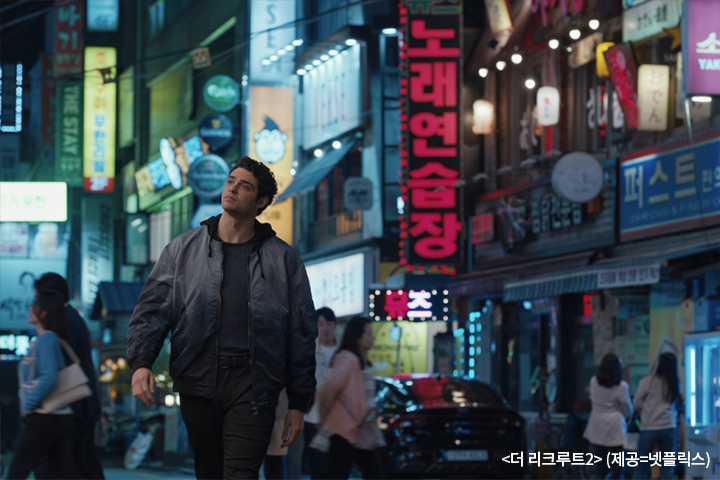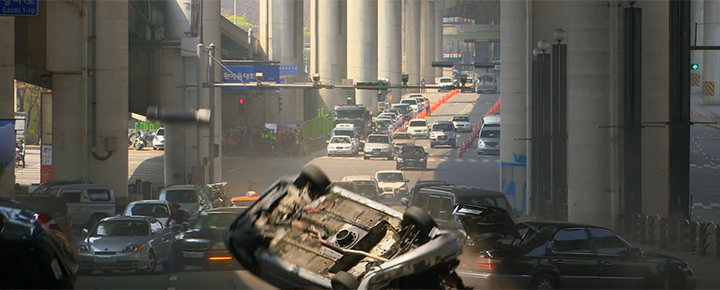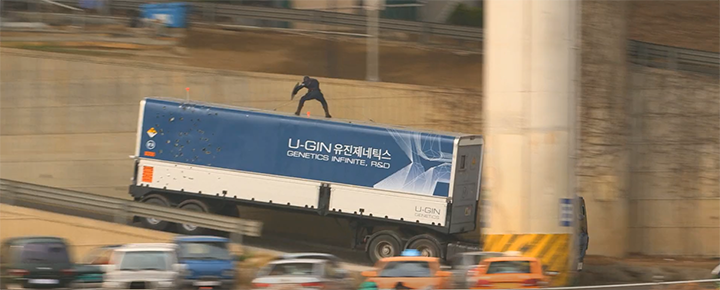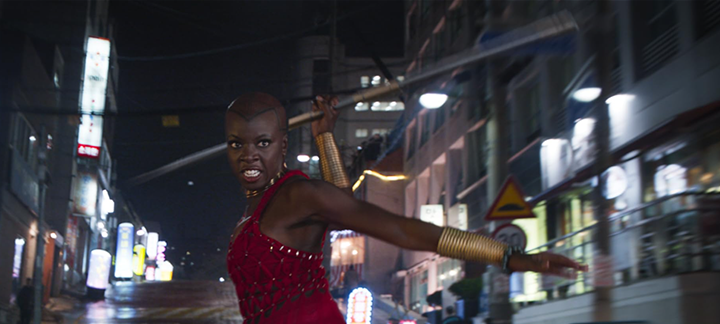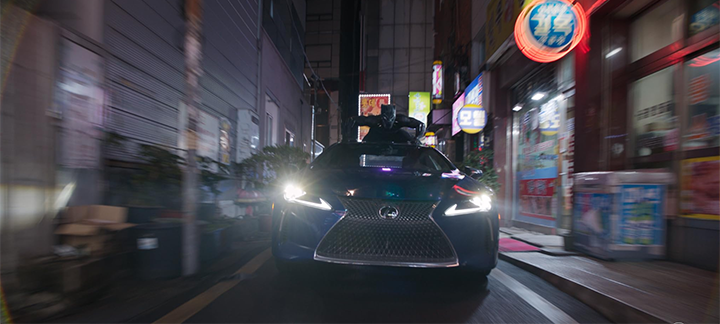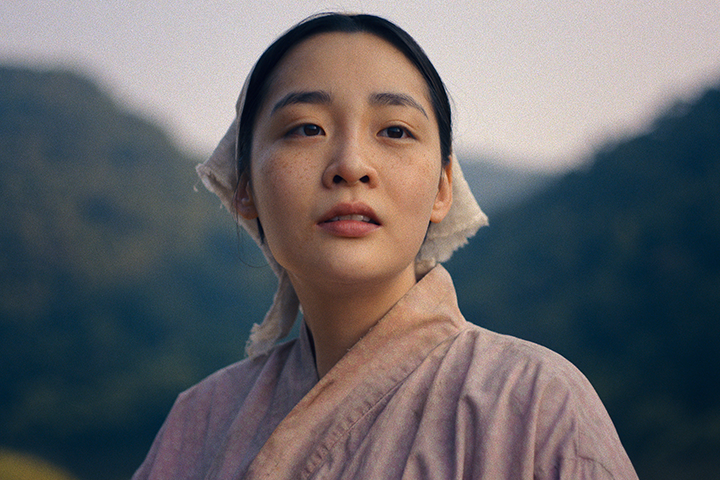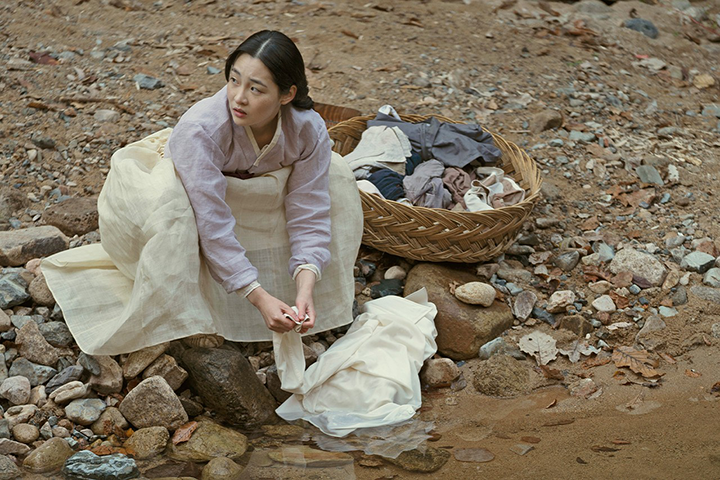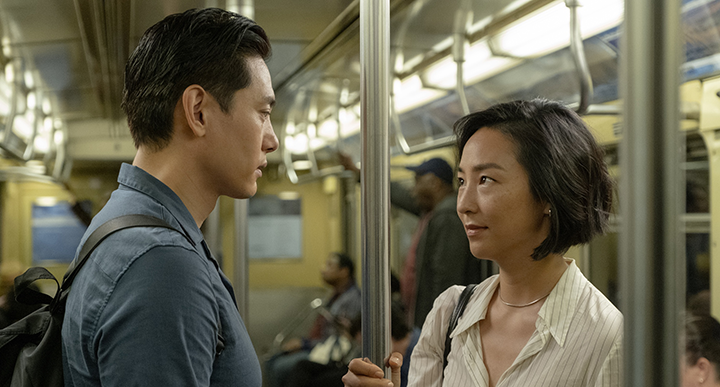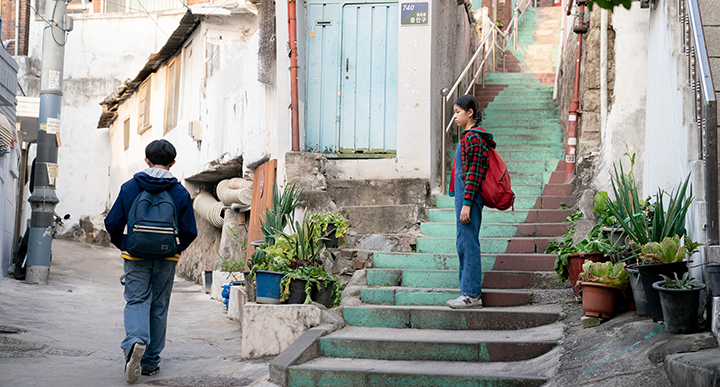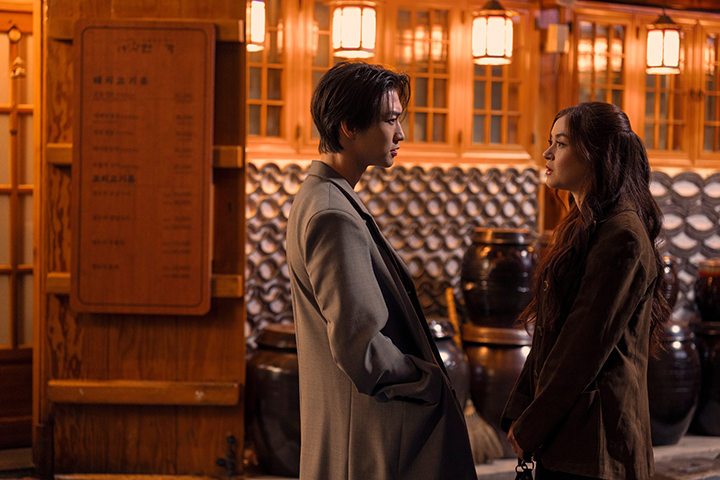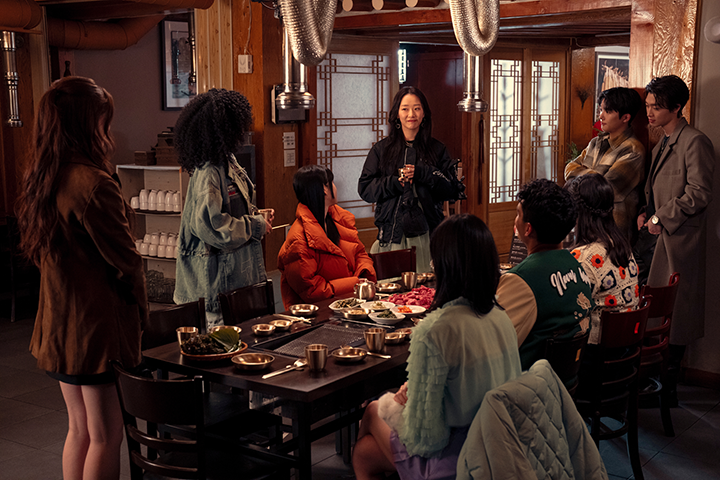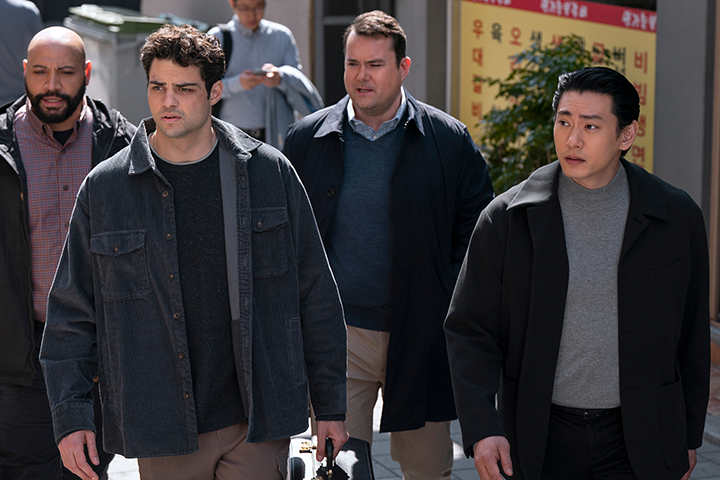<어벤져스>에서 <엑스오, 키티>까지, 한국이 촬영되는 방식
외화 속 국내 로케이션을 마주하는 것은 이제 낯선 경험이 아니다. 마블 시네마틱 유니버스(이하 마블) 시리즈인 <어벤져스: 에이지 오브 울트론>(2015)은 한국을 로케이션 삼은 첫 어벤져스 시리즈였다. 어벤져스 멤버와 친밀한 한국인 과학자 ‘헬렌 조’가 등장하며 액션 신 배경이 서울로 설정된다. 서초구 세빛섬, 마포대교와 청담대교 등 상징적인 장소 외에도 마포구 상암동과 영등포구 문래동 철강단지, 강남대로 등 서울 도심 구석구석이 찍혔다. 마블 시리즈의 ‘한국 촬영’은 해외 제작진과 한국 관객 사이의 상호 관심에 따른 결과이기도 했다. <어벤져스: 에이지 오브 울트론>은 마블 시리즈 최초로 천만 관객을 동원했다. 이어 <캡틴 아메리카: 시빌 워>(2016), <스파이더맨: 홈커밍>(2017)까지 마블 시리즈는 3년 연속 국내 외화 흥행 1위를 차지했다. 이후 <블랙팬서>(2018) 팀은 부산을 주목했다. 부산 수영구 광안해변로와 광안대교의 야경은 주인공들의 자동차 추격 신을 화려하게 채웠다.
<어벤져스: 에이지 오브 울트론> (제공=영화 예고편)
<블랙팬서> (제공= IMDb)
팬데믹 이후 글로벌 온라인동영상서비스(OTT)가 부상하며, 로케이션으로서의 한국은 극장 밖으로도 뻗어 나갔다. 이때부터는 단순한 관심을 넘어, 기획 단계부터 한국을 주무대로 고려한 작품이 눈에 띈다. 2020년 촬영에 들어갔던 애플tv 오리지널 드라마 <파친코>(2022)가 대표 격이다. <파친코>의 원작을 쓴 이민진 작가는 한국계 미국인이다. 그는 부산 영도 출신으로 일본에서 살게 된 1915년생 여성 ‘선자’를 주인공으로 세웠다. 미국 캘리포니아 할리우드에 본사를 둔 미디어 레스 스튜디오가 제작하고, 글로벌 OTT 애플tv에서 공개된 <파친코>가 부산을 주요 배경으로 삼은 이유다. <파친코>의 경우 부산 외에도 목포, 합천, 안동, 대전 등을 이동하며 야외 신 촬영이 이뤄졌다.
<파친코> (제공=애플tv)
유태오와 그레타 리가 주연한 영화 <패스트 라이브즈>(2023)의 사례도 유사하다. 20년 만에 재회한 두 한국인 친구의 이야기를 그린 로맨스 드라마 장르로, 서울과 뉴욕을 배경으로 했다. 각본과 연출을 맡은 셀린 송 감독은 열두 살 때까지 한국에서 살다가 캐나다로 이민을 간 자신의 경험을 영화에 녹였다. 특히 실제 한국에 살고 있는 사람들이 ‘한국답다’고 느낄 만한 곳을 골라낸 점이 독특하다. 남산타워처럼 상징적인 공간보다 스태프들의 경험을 바탕으로 로케이션을 선정한 것이다. 로케이션 매니저가 일이 끝난 후 찾으려 했던 술집, 막내 AD가 군 복무 중 행군했던 길 등을 로케이션지로 택했다.
<패스트 라이브즈>(제공=CJ ENM)
최근 한국을 로케이션으로 쓴 작품들은 다른 양상을 보인다. ‘한국 문화에 관심 있는 외국인’으로 타깃을 정밀하게 좁혔다. 2023년 시작된 넷플릭스 <엑스오, 키티> 시리즈는 100% 한국 로케이션 작품이다. 넷플릭스 하이틴 로맨스 영화 <내가 사랑한 모든 남자들에게>(2018)의 스핀오프로, 주인공 키티가 어머니의 모교인 서울국제고등학교에 진학해 한국인 연인과 재회한다는 설정에 기반해 한국을 담았다. 키티와 친구들은 서로의 우정과 진심을 나누는 장소로 성동구 연무장길, 종로구 젊음의 거리, 한강공원 등 말 그대로 서울의 ‘핫플레이스’를 택한다.
한국을 담았지만 한국인 입장에서 낯선 로케이션도 있다. 또 다른 넷플릭스 시리즈 <더 리크루트 > 시즌 2(2025)의 경우로, CIA 변호사 오웬 헨드릭스가 한국 국가정보원 요원인 장균을 만나며 시작되는 드라마다. 로케이션은 대부분 액션 신에 해당하며, 잠실 롯데타워와 강남대로 등 서울 도심 한복판의 야경이 담겼다. 초반부 등장하는 호텔과 기지로 쓰이는 모텔의 묘사는 액자에 특정 문장이 한글로 반복되어 적혀 있거나 일본 애니메이션풍 캐릭터가 디자인되어 있는 등 실제 한국의 공간과는 차이가 있다. 글로벌 시청자를 타깃으로 했기에 생기는 이질감이다.
<엑스오, 키티> (제공=넷플릭스)
<더 리크루트2> (제공=넷플릭스)
K-로케이션, 지원은 어떻게?
OTT가 부상하던 2020년은 한국 문화의 세계적 주목도가 높아진 해이기도 하다. 2019년 이후 봉준호 감독의 <기생충>이 칸국제영화제 황금종려상 수상과 아카데미에서 작품상 등 5개 부문 수상, <미나리>(2020)의 윤여정 배우가 아카데미 여우조연상을 수상했다. BTS와 블랙핑크가 빌보드 차트를 석권한 2017년 이후, K-팝이라는 고유명사에 붙었던 ‘K’는 영화와 드라마의 수식어로서도 자리매김하기 시작했다.
산업 최전선의 프로듀서들 또한 수요의 변화를 체감하고 있다. <어벤져스: 에이지 오브 울트론>(2015)의 한국 로케이션을 담당한 프로덕션 서비스 회사의 경우 2015년 당시 1년에 한 작품씩 제안이 들어왔으나, 2024년 하반기 기준 6건의 제안이 들어올 정도로 수요가 가파르게 증가했다.
로케이션 인센티브 지원사업을 담당하는 영화진흥위원회(이하 영진위)와 서울영상위원회, 부산영상위원회 등 지역영상위원회 또한 지원의 폭을 늘렸다. 영진위는 한국에서 촬영하는 ‘외국 영상물’을 대상으로 ‘영화영상 로케이션 지원사업’을 시행 중이다. 2011년부터 시작된 이 지원사업은 2025년 기준 한국에서 5일 이상 촬영하고 한국 집행 비용이 최소 4억 원 이상(예능, 광고, 스포츠 이벤트, 교육 프로그램은 제외)인 작품을 대상으로 한다. 환급 금액은 국내 영상인력 및 업체 대상 지출 비용의 25%로, 최대 4억 원(국제공동제작영화 기준, 외국 영상물의 경우 3억 원)까지 지원된다. 지원 금액은 한국에서의 촬영이 모두 끝나고 제출된 보고서를 기준으로 책정되며, 해당 금액을 제작사에 환급하는 방식이다. 지역영상위원회의 지원이 지방자치단체 집행 비용에 집중된 것과 달리, 영화진흥위원회의 지원은 국내 인력 인건비와 국내 후반업체 인프라 이용비 지원을 대상으로 했다는 점이 눈에 띈다.
지역영상위원회 역시 작품 유치를 위한 로케이션 지원사업을 꾸준히 해 왔다. 지역 입장에서 해외 프로덕션의 촬영은 관광지화를 통한 지역 홍보, 나아가 지역을 리브랜딩할 수 있는 기회이기 때문이다. <블랙팬서>(2018) 한국 촬영의 경우, 지자체 공무원과 경찰 병력이 동원되어 부산 광안해변로 800m 등의 로케이션에 차량 통제 등 현장 지원이 이뤄졌다. <블랙팬서>의 부산 홍보 효과를 그만큼 높게 평가한 것이다. 올해 방영 예정인 아마존프라임비디오의 시리즈 <버터플라이>의 제작자이자 주인공인 배우 다니엘 대 킴은 서울시 명예시민증을 받기도 했다. <버터플라이>는 지난해 한국에서 4개월간 80회 전회차를 촬영했다.
지원 대상 국가의 다양성도 갖춰지는 모양새다. 10여 년간 사업을 진행해 온 부산영상위원회의 경우 지난해를 기준으로 익히 알려져 있는 미국, 일본 작품 외에도 대만, 말레이시아, 몽골 작품이 지원 대상이 되었다. 지역이 로케이션이 될 경우 ‘관광 효과’라는 간접적 이점만 생기는 것은 아니다. 촬영 기간 동안 머물며 숙식을 해결하는 몇 백 명의 스태프들은 지역 소상공인에게 활기를 불어넣는다. 한국 스태프의 고용 창출 효과도 크다. 영진위는 지난해부터 로케이션 지원사업을 통해 국내 영화 인력 지원을 꾀하는 방식으로 사업 대상을 확장하고 있다. 영화와 OTT 시리즈의 스태프 간 경계가 흐려졌기 때문에 시리즈 촬영이 늘면 영화 산업에도 긍정적인 영향을 끼친다고 본 것이다.
영진위의 ‘영화영상 로케이션 지원사업’은 지원 대상인 ‘외국 영상물’의 범위가 현재보다 좁았었다. 2023년까지는 제작 투자 지분 중 해외 자본이 80% 이상인 경우에만 ‘외국 영상물’로 정의, 지원 대상에 해당되었는데 지난해부터 한국 자본 20% 이하, 한국에서 지식재산권(IP)을 보유하고 있는 경우더라도 지원받을 수 있도록 사업이 확장 개편되었다. 올해 접수된 작품 건수는 지난해 대비 30% 증가했다. 이는 지원금의 출처가 한국관광공사에서 관리하는 관광기금 위탁 지원에서 영화발전기금 편성 지원으로 바뀌고 사용 목적에 ‘한국영화 진흥 임무’가 포함되며 생긴 변화다. 영진위는 이러한 ‘공동제작’ 작품이 늘고 국내 제작사들이 해외 자본을 끌어와서 지원을 받을 경우 국내 영상물의 국제 역량이 늘어날 것이라고 기대하고 있다.
신선함과 편리함을 넘어서
로케이션으로서 한국은 어떤 매력이 있을까. 간단하게 말하자면 ‘신선함’과 ‘편리함’이다. 동아시아 3국 가운데 일본은 이미 다양한 방식으로 해외 영화 속에서 문화적으로 소비되었고, 중국은 촬영 심의를 거쳐야 하는 어려움이 있다. 아직까지 한국은 로케이션지로 신선하게 소비되며 촬영 인프라도 갖춰져 있어 ‘촬영하기 좋은 나라’라는 인식이 형성되었다. 그러나 신선함에 기댄 매력은 유통기한이 짧다.
신선함을 유지하는 데에 있어서 아쉬운 것은 인센티브 규모다. 해외 제작사 입장에서 로케이션 인센티브 지원사업의 인센티브 규모는 촬영지 선정에 있어 가장 중요한 결정 기준이 되기 때문이다. 대체 가능한 촬영지라면 값이 조금이라도 더 싼 곳을 선택하는 것은 당연한 수순이다. 그러나 한국의 인센티브 규모는 일본 등 함께 로케이션 후보군으로 오르는 나라들에 비해 턱없이 부족하다. 일본의 경우 최대 로케이션 인센티브 비율이 50%이며 최대 10억 엔(약 100억 원, 2023년 기준)을 지원한다. 태국의 경우 비율은 15~20% 정도로 한국과 비슷하나 최대 인센티브는 작품당 1억 5000만 바트(약 56억 원, 2024년 기준)에 달한다.
촬영 인프라가 갖춰져 있다고는 하나, ‘한국스러운’ 장면을 담을 때 신경 써야 할 저작권 문제의 해결도 다소 번거로운 상황이다. 해외 제작사의 경우, 글로벌 OTT 플랫폼 등 규모가 클수록 로케이션 계약서의 사전 조율을 원한다. 한국 제작사는 촬영이 먼저 이뤄지고 사후에 계약을 정리하는 일도 많기 때문에 해외 제작사와 계약해야 할 국내 촬영지 입장에서 난감해하는 경우가 많다. 로케이션 표준계약서 등을 통해 국내외 제작사들이 로케이션 활용에 편리함과 신뢰를 느낄 수 있도록 만들어 가야 한다.
로케이션 훼손 방지를 위한 시스템을 구축할 필요도 있다. 촬영지에 거주하는 시민들의 일상이 심각하게 침해되거나, 관광지 보존이 어려울 정도의 촬영은 지속 가능한 로케이션 활용의 측면에서도 제지가 필요하다. 지자체 차원의 관리가 보증될 경우 촬영지 입장에서도 안심하고 찍을 수 있다.
공개와 동시에 전 세계 사람들이 볼 수 있는 OTT 플랫폼의 영향력 확대로 촬영지와 촬영자의 경계는 점점 더 흐려질 전망이다. 그동안 한국이란 원석은 많은 이들의 노력으로 다듬어져 매력적인 로케이션으로 거듭났다. 이제 차별화가 필요하다. 지원 규모의 확대와 촬영 환경 개선을 통해 로케이션으로서의 한국이 더 빛날 수 있기를 기대해본다.
K로케이션
한국로케이션붐
글로벌촬영지
K콘텐츠
한국촬영유치
외국영상물지원
한국촬영지
한국콘텐츠글로벌화
GLOBAL
From a “Film-Friendly Country” to a “Premier Filming Destination”
Reimagining K-Locations for Global Appeal
By Choi Hye-ri (Culture Desk Reporter, JoongAng Ilbo)
2025-06-16
From The Avengers to XO, Kitty:
How Korea Is Captured on Screen
Coming across Korean locations in mainstream films is no longer a novelty. Avengers: Age of Ultron (2015), part of the Marvel Cinematic Universe (MCU), was the first film in the franchise to use Korea as a filming location. The story features Dr. Helen Cho, a Korean scientist closely associated with the Avengers, and includes a major action sequence set in Seoul. Alongside iconic landmarks such as Sebitseom Island in Seocho-gu, Mapodaegyo Bridge, and Cheongdamdaegyo Bridge, the film also highlights lesser-known parts of the city—including the steel factory complex in Mullae-dong, Yeongdeungpo-gu; Sangam-dong in Mapo-gu; and Gangnam-daero. Marvel’s decision to use locations in Korea reflected a mutual interest between the international production team and Korean audiences. Avengers: Age of Ultron became the first Marvel film to surpass 10 million admissions in Korea. The trend continued with Captain America: Civil War (2016) and Spider-Man: Homecoming (2017), both of which topped Korea’s foreign film box office for three consecutive years. Then came Black Panther (2018), which shifted its focus to Busan. The nightscape of Gwangalli Beach Road and Gwangandaegyo Bridge in Suyeong-gu provided a striking backdrop for a high-speed car chase, adding a dynamic cinematic flair to the film.
<Avengers: Age of Ultron>
(Courtesy of the film trailer)
<Black Panther> (Courtesy of IMDb)
Since the pandemic, the rise of global streaming platforms has expanded Korea’s presence as a filming location far beyond the confines of movie theaters. No longer just a backdrop of passing interest, Korea began to feature prominently in the early planning stages of various productions. A prime example is the Apple TV+ original series Pachinko (2022), which began filming in 2020. Based on the novel by Korean American author Min Jin Lee, Pachinko follows the life of Sunja, a woman born in 1915 on Yeongdo Island in Busan, who later emigrates to Japan. With the series produced by LA-based Media Res Studio and distributed globally by Apple TV+, Busan naturally emerged as one of the drama’s main settings. The production also filmed outdoor scenes across several Korean cities, including Mokpo, Hapcheon, Andong, and Daejeon.
<Pachinko> (Courtesy of Apple TV)
A similar example is Past Lives (2023), a romantic drama starring Teo Yoo and Greta Lee. The film follows two childhood friends from Korea who reconnect after 20 years, with the story unfolding between Seoul and New York City. Director and screenwriter Celine Song, who emigrated to Canada from Korea at the age of 12, drew heavily from her own experiences in crafting the narrative. What sets Past Lives apart is its thoughtful selection of Korean filming locations—places that resonate as authentically “Korean” to those who live there. Rather than opting for iconic landmarks like Namsan Tower, the production chose locations based on the experiences of the crew. One scene was shot in a bar the location manager had planned to visit after work, while another took place on a trail the youngest assistant director had once marched during his military service.
<Past Lives> (Courtesy of CJ ENM)
More recent productions that feature Korea as a filming location have shifted their focus, narrowing in on global viewers with an interest in Korean culture. A notable example is the Netflix series XO, Kitty, which premiered in 2023 and was filmed entirely in Korea. A spin-off of the teen romance film To All the Boys I’ve Loved Before (2018), the series follows Kitty as she enrolls at the Korean Independent School of Seoul—her late mother’s alma mater—and reunites with her Korean boyfriend. Throughout the series, Kitty and her friends share moments of friendship and heartfelt conversations at some of Seoul’s trendiest spots, including Yeonmujang-gil in Seongdong-gu, Youth Street in Jongno-gu, and the scenic Hangang Park.
<XO, Kitty> (Courtesy of Netflix)
Some productions feature Korean settings that may feel unfamiliar even to Korean audiences. A case in point is Season 2 of the Netflix series The Recruit, which opens with CIA lawyer Owen Hendricks meeting a Korean National Intelligence Service agent named Jang Kyun. Most of the Korean scenes are action-packed and set against the nighttime cityscape of central Seoul, showcasing landmarks such as Lotte World Tower in Jamsil and Gangnam-daero. However, certain settings—like the hotel that appears early on or the motel used as a base—include wall art featuring repetitive Korean phrases and characters reminiscent of Japanese anime, creating a visual dissonance from authentic Korean spaces. This disconnect likely reflects the production’s orientation toward a global audience rather than local authenticity.
<The Recruit Season 2>
(Courtesy of Netflix)
K-Locations – How Is Support Provided?
The year 2020, which saw the rapid rise of OTT platforms, also marked a turning point for global interest in Korean culture. The international acclaim for Director Bong Joon-ho’s Parasite—winner of the Palme d’Or at the 2019 Cannes Film Festival and five Academy Awards, including Best Picture—solidified Korean cinema’s global standing. This momentum continued with Youn Yuh-jung’s Oscar win for Best Supporting Actress in Minari (2020). Meanwhile, BTS and BLACKPINK had already been dominating the Billboard charts since 2017, helping to redefine the “K” in K-pop as a broader cultural marker encompassing Korean film and television as well.
Producers on the frontlines of the industry are also seeing a clear shift in demand. The production service company that managed the Korean location work for Avengers: Age of Ultron (2015) noted that, at the time, they received only about one proposal per year. By the second half of 2024, however, that number had risen to six, reflecting a sharp uptick in interest.
Regional organizations responsible for location incentive programs—such as the Korean Film Council (KOFIC), the Seoul Film Commission, and the Busan Film Commission—have significantly expanded their support in recent years. KOFIC currently operates the Location Incentive Program for foreign audio-visual works, designed to attract international productions to film in Korea. Launched in 2011, the program supports foreign productions (excluding variety shows, commercials, sports events, and educational content) that shoot in Korea for at least five days and spend a minimum of KRW 400 million locally. As of 2025, the program offers reimbursements of up to 25% of eligible expenses related to Korean personnel and service providers. The maximum reimbursement is KRW 400 million for international co-productions and KRW 300 million for fully foreign productions. Reimbursements are determined based on a final report submitted after filming is completed in Korea and are paid directly to the production company. Unlike regional film commissions, which typically focus support on expenditures made through local governments, KOFIC’s program is notable for prioritizing labor costs for domestic staff and service providers.
Regional film commissions have also maintained active location support programs to attract international productions. From a local standpoint, hosting a foreign shoot presents a valuable opportunity to promote the region as a travel destination—or even to rebrand its image altogether. For instance, during the filming of Black Panther (2018) in Korea, local government officials and police provided extensive on-site support, including traffic control along an 800-meter stretch of Gwangalli Beach Road in Busan—an indication of the high promotional value attributed to the production. More recently, actor Daniel Dae Kim, who both stars in and produces the upcoming Amazon Prime Video series Butterfly, was named an honorary citizen of Seoul. The production filmed all 80 scenes of the series over a four-month period in Korea last year.
The range of countries eligible for support is also becoming increasingly diverse. Take the Busan Film Commission, which has operated its program for over a decade. As of last year, in addition to well-known productions from the U.S. and Japan, the commission has extended support to projects from Taiwan, Malaysia, and Mongolia. The benefits of hosting a location shoot extend far beyond tourism exposure. When a region serves as a filming site, the influx of hundreds of crew members—who rely on local lodging and dining during production—provides a significant boost to the local small business economy. The impact on employment for Korean film crews is equally notable. In response, KOFIC has expanded its support program since last year to more directly benefit Korean film professionals. As the lines between film and OTT series production continue to blur, the rise in series production is now viewed as a positive driver for the broader film industry.
KOFIC’s Location Incentive Program originally had a narrower definition of what qualified as a “foreign production.” Until 2023, only projects with over 80% of their production investment coming from overseas were eligible for support. However, starting last year, the program was expanded and restructured to include works with less than 20% Korean capital, even if the intellectual property (IP) is held in Korea. As a result, the number of applications submitted this year has increased by 30% compared to the previous year. This change is largely due to the tourism fund managed by the Korea Tourism Organization being shifted to allocations from the Film Development Fund, which now includes “the promotion of Korean cinema” as part of its designated purpose. KOFIC anticipates that as the number of these “co-productions” grows and more Korean production companies attract foreign investment, the international competitiveness of Korean content will also grow.
Beyond Novelty and Convenience
What makes Korea appealing as a filming location? Simply put: “novelty” and “convenience.” Among the three East Asian countries, Japan has already been extensively featured and culturally consumed in global cinema, while China faces challenges due to strict filming regulations and censorship. For now, Korea still offers a sense of freshness as a location and boasts a well-established production infrastructure that has helped build its reputation as a “film-friendly” country. However, any appeal based solely on novelty has a limited shelf life.
One challenge in maintaining Korea’s appeal as a fresh filming location lies in the scale of its incentive programs. For overseas production companies, the size of location incentives is often the single most important factor in deciding where to film. When filming locations are interchangeable, it’s only natural to choose the more cost-effective option. However, Korea’s incentive offerings fall significantly short compared to countries frequently considered alongside it, such as Japan. In Japan, the maximum location incentive covers up to 50% of eligible costs, with a cap of JPY 1 billion (approximately KRW 10 billion as of 2023). Thailand offers a similar reimbursement rate to Korea (around 15% to 20%), but its maximum incentive per project reaches THB 150 million (roughly KRW 5.6 billion as of 2024).
While Korea boasts a well-developed production infrastructure, navigating copyright issues—especially when filming scenes that are distinctly “Korean”—can be cumbersome. Large-scale international productions, particularly those affiliated with global OTT platforms, often prefer to finalize location contracts in advance. However, since Korean production companies frequently proceed with filming first and settle contracts afterward, domestic location providers often find themselves in a difficult position when working with foreign productions. To address this, there is a growing need for standardized location agreements and frameworks that can offer both Korean and international producers greater convenience and confidence when using filming locations in Korea.
There is also a need to establish systems that prevent damage to filming locations. When shooting disrupts the daily lives of local residents or threatens the preservation of cultural or tourist sites, regulations must be put in place to ensure the sustainable use of these locations. With proper oversight at the municipal level, location owners and communities can feel more secure in accommodating film crews.
As the influence of OTT platforms—where content is instantly accessible to viewers worldwide—continues to grow, the boundaries between filming locations and those behind the camera are expected to blur even further. Over the years, Korea has been shaped and refined into an attractive filming destination through the efforts of many. Now, it is time to take the next step. By expanding support programs and improving filming conditions, Korea has the potential to shine even brighter as a premier location for storytelling.

